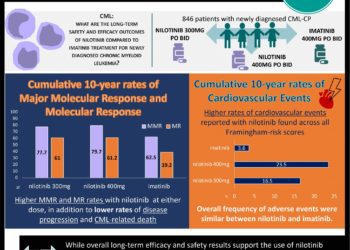Treatment-free remission of chronic myeloid leukemia possible after second-line nilotinib
1. Phase 2, open-label study results suggest that treatment-free remission (TFR) of chronic myeloid leukemia (CML) for ≥48 weeks can be reached by over half of patients who have reached deep molecular response (DMR) after ceasing second-line nilotinib treatment.
2. The authors suggest that for patients who do not reach sustained DMR with imatinib, changing to nilotinib may help more patients reach TFR.
Evidence Rating Level: 1 (Excellent)
Study Rundown: A rising treatment goal for CML is TFR, which is the maintenance of response after ceasing tyrosine kinase inhibitor (TKI) therapy. Benefits of TFR include avoiding treatment side effects, decreased risk of toxicity from long-term TKI use, and family planning possibilities. This Phase 2, open-label study assessed TFR after termination of second-line nilotinib therapy. Researchers studied 163 patients who had reached sustained DMR following a change from imatinib to nilotinib to see if these patients could stay in remission without TKI. Researchers found that 58% of patients maintained TFR at the primary end point of 48 weeks. At 96 weeks, 53% of patients maintained TFR. The results indicate that TFR can be attained by CML patients who have reached DMR after ceasing second-line nilotinib treatment. The authors suggest that for patients who do not reach sustained DMR with imatinib, changing to nilotinib may help more patients reach TFR. The authors advised that any treatment switching decisions should factor in both risks and benefits of TKIs.
This was the first large prospective study to examine TFR with a specific focus on patients who attained sustained DMR only following a change from imatinib to nilotinib. Study limitations included a heterogeneous patient group and the inability to compare between patients continuing or stopping treatment.
Click to read the study in Annals of Internal Medicine
Relevant Reading: The use of nilotinib or dasatinib after failure to 2 prior tyrosine kinase inhibitors: long-term follow-up
In-Depth [prospective cohort]: Researchers screened 256 patients between December 2012 and December 2013. The 163 enrolled patients were ≥18 years of age, had CML in chronic phase, had an Eastern Cooperative Oncology Group (ECOG) performance status of 0 to 2, were getting TKI treatment for ≥3 years (imatinib for >4 weeks, followed by nilotinib for ≥2 years), and had reached MR4.5 (a molecular response benchmark of BCR-ABL1 ≤0.0032% on the International Scale) while taking nilotinib after a switch from imatinib treatment. Of the 163 enrollees, 126 were qualified for entrance to the TFR phase and to halt nilotinib treatment. Of these patients, 73 (58%) of patients maintained TFR at the primary end point of 48 weeks. At 96 weeks, 67 (53%) of patients maintained TFR. Fifty-five of the 56 patients resumed nilotinib treatment regained major molecular response (MMR) (BCR-ABL1 ≤0.1%) or better. None of these patients had CML advancement to the accelerated phase or blast crisis. In the first 48 weeks after terminating nilotinib, musculoskeletal pain was more common. In comparison to the TFR group, the 37 patients without TFR entry had a greater period from diagnosis of CML to study initiation, a longer duration of prior TKI treatment (mainly due to a longer period of imatinib treatment), and a briefer MR4.5 time before starting the study.
Image: CC/Wiki
©2018 2 Minute Medicine, Inc. All rights reserved. No works may be reproduced without expressed written consent from 2 Minute Medicine, Inc. Inquire about licensing here. No article should be construed as medical advice and is not intended as such by the authors or by 2 Minute Medicine, Inc.







